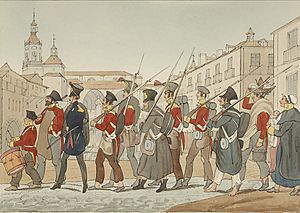British Auxiliary Legion facts for kids

The British Auxiliary Legion, also known as the British Legion, was a special military group from Britain. It existed from 1835 to 1837. This force was sent to Spain to help the Liberals and Queen Isabella II of Spain. They fought against a group called the Carlists during a conflict known as the First Carlist War.
Contents
History of the Legion
Britain was already helping Spain by controlling sea traffic along the northern coast. This was part of an agreement called the 1834 Quadruple Alliance.
In 1835, the war was not going well for the Liberals in Spain. They asked their allies, including Britain, for more help. France sent its Foreign Legion, which arrived in Spain with about 4,000 soldiers.
Britain decided not to send its regular army. Instead, in June 1835, they formed a group of volunteer soldiers. This group became the British Auxiliary Legion. The Spanish government agreed to pay for and support these soldiers.
By late 1836, about 10,000 men of the Legion had gathered in San Sebastian in the Basque Country. Their leader was De Lacy Evans. They fought in battles near Hernani and Vitoria. They were pushed back and had to defend Mount Urgull in San Sebastian to stop the Carlists from taking the city.
In November 1836, the Legion joined forces with Baldomero Espartero, a Spanish general. Together, they helped to end the Carlist attack on Bilbao.
In 1837, the Legion faced a tough defeat at the Battle of Oriamendi. However, they later launched a successful attack along the Biscay coast. This attack was a response to the Carlists trying to march on Madrid. During this push, the Legion and Spanish forces managed to capture the town of Irun.
The volunteers had signed up to serve for two years. By July 1837, most of them had finished their service and returned home. Many sailed back on ships like the Prince Regent and the Parmelia.
About 1,500 to 1,700 soldiers chose to stay and formed a group called the New Legion. This group was led by Brigadier-General Maurice O'Connell. They suffered heavy losses, especially during their defeat at the battle of Andoain on September 14. After this, the New Legion was no longer a strong fighting force. It was officially ended on December 10, 1837.
In total, about a quarter of the Legion's soldiers, around 2,500 men, died. Only half of these deaths happened in combat. The Carlists did not like the British Legion at all. One former soldier wrote that the Carlists saw them as "strangers, paid soldiers, and outsiders." He explained that if a Legion soldier was captured, they often faced a very harsh fate.
How the Legion Was Organized
Most of the 9,600 men in the Legion were volunteers. They often came from British Army regiments. The only regular British troops who served in this war were from the Royal Navy, Royal Marines, Royal Artillery, and Royal Engineers. Recruiting and training for the Legion started in 1835. The plan was for the Legion to have 8,500 foot soldiers (infantry), 550 riflemen, 700 cavalry (soldiers on horseback), and 300 artillery (soldiers who operate cannons).
Legion Units
The Legion was divided into different types of fighting groups:
- Cavalry – Soldiers on horseback. There were two regiments:
- 1st Reina Isabel Lancers (English)
- 2nd Queen's Own Irish Lancers (Irish)
- Infantry – Foot soldiers. There were ten battalions (large groups of soldiers). These were organized into "English," "Scottish," and "Irish" brigades. Each battalion had different companies, including light companies (for quick movements) and grenadier companies (often elite soldiers).
- 1st English Battalion
- 2nd English Battalion
- 3rd Westminster Grenadiers (English)
- 4th Queen's Own Fusiliers (English)
- 5th Scotch (Scottish)
- 6th Scotch Grenadiers (Scottish)
- 7th Irish Light Infantry (Irish)
- 8th Highlanders (Scottish)
- 9th Irish Grenadiers (Irish)
- 10th Munster Light Infantry (Irish)
The 7th, 9th, and 10th Irish battalions were grouped together under Brigadier-General Charles Shaw. This group became known as one of the toughest units in the Legion.
- Light Infantry – The Rifle Brigade, British Auxiliary Legion (soldiers trained for quick attacks and skirmishes).
- Artillery – English (soldiers who used cannons).
- Corps of Sappers and Miners – A mixed group of soldiers who built fortifications and dug tunnels.
- Hospital Transport Corps – A mixed group that helped move injured soldiers.
British Regulars Who Helped the Legion
Sometimes, regular British troops worked alongside the Legion. These included:
- Royal Marines – About 400 men, including the Royal Marine Artillery.
- Royal Artillery – Soldiers who operated cannons.
- The Chapelgorris – A Spanish volunteer unit that joined the Legion from 1836.
The first British Marines arrived in April 1836 to protect Portugalete. Later, more Marines joined, and small groups of Royal Marine Artillery, Royal Artillery, and Royal Engineers also came to help.
In November 1836, 39 officers and men from the British Royal Artillery joined the naval forces supporting the Legion. More arrived in January 1837. These artillery units used different types of cannons and rockets.
British Auxiliary Brigade (1838–39)
After the main British Auxiliary Legion left in 1837, a smaller group of about 400 British volunteers stayed. This group was formed in March 1838 and became part of the Spanish army. It was called the Brigada Auxiliar Británica (British Auxiliary Brigade). It was led by Colonel Federico Ricardo Lasaussaye.
Early on, many soldiers in the Brigade got sick with a fever. But the unit, especially its cavalry, helped the Spanish forces capture a Carlist stronghold called Barásoain. They also fought successfully against Carlist cavalry at Sesma.
See also
- Foreign legion
- Foreign volunteers


